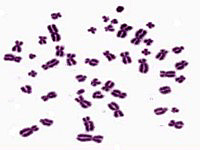In the Department of Radiation and
Environmental Biology are established several methods of measuring
various types of mutations or DNA and chromosome damage. Routine
methods and various laboratories facilities are applied in the
Department's activities in the following fields:
- Monitoring of the environmental exposures effects by:
- In situ or in vitro analysis of gene
mutations of color or lethal frequency in somatic cells of Tradescantia

- Cytogenetic damage in human lymphocytes: in metaphases of the first and second division
- Micronuclei in buccal cells
- In situ or in vitro analysis of gene
mutations of color or lethal frequency in somatic cells of Tradescantia
- Retrospective biological dosimetry:
- Analysis of the DNA damage by single cell gel
electrophoresis assay (Comet)

- Evaluation of the adsorbed dose on the base of
- unstable chromosome aberration frequencies
(dicentrics, rings, fragments detected with the microscope conjugated
with an automatic metaphase finder)

- stable chromosome aberration - translocations
(analyzed with FISH)

- unstable chromosome aberration frequencies
(dicentrics, rings, fragments detected with the microscope conjugated
with an automatic metaphase finder)
- Analysis of the DNA damage by single cell gel
electrophoresis assay (Comet)
- Studies of the susceptibility to the genotoxic action
of environmental agents:
- studies on variation between individuals in response to challenging dose of UV or X-rays
- studies on the repair capacity of the damage induced by a challenging dose
- comparative studies on susceptibilities and repair capacities of healthy donors and cancer patients
- Studies of interaction between physical and chemical agents
- Studies on biological efficiency of vavious sources of ionizing radiation.
- Teaching courses:
- Lectures on molecular epidemiology and radiation and environmental biology
- Laboratory training
- dose response relationship for the cell survival, gene mutation frequency and cell cycle factor
- spare effect after fractionated dose
- comparison between various persons' responses to chemical exposure based on analysis of SCE and HFC in human lymphocytes
- relative biological efficiency of various therapeutic beams in the induction of chromosome aberrations
- DNA damage analysis after combined treatment of lymphocytes by chemical and radiation
- Training on human monitoring